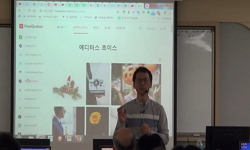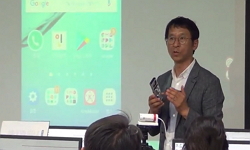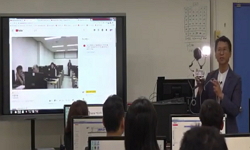Joseon Dynasty(1392 - 1910) was based on Neo-Confucianism and focused on cultivating talent and edification. So the government established educational institutions especially like those of Sungkyunkwan, Sahak and Hyanggyo. But over time, management of...
http://chineseinput.net/에서 pinyin(병음)방식으로 중국어를 변환할 수 있습니다.
변환된 중국어를 복사하여 사용하시면 됩니다.
- 中文 을 입력하시려면 zhongwen을 입력하시고 space를누르시면됩니다.
- 北京 을 입력하시려면 beijing을 입력하시고 space를 누르시면 됩니다.
https://www.riss.kr/link?id=A82675301
- 저자
- 발행기관
- 학술지명
- 권호사항
-
발행연도
2011
-
작성언어
-
- 주제어
-
KDC
300
-
등재정보
KCI등재
-
자료형태
학술저널
-
수록면
55-78(24쪽)
-
KCI 피인용횟수
5
- DOI식별코드
- 제공처
-
0
상세조회 -
0
다운로드
부가정보
다국어 초록 (Multilingual Abstract)
Joseon Dynasty(1392 - 1910) was based on Neo-Confucianism and focused on cultivating talent and edification. So the government established educational institutions especially like those of Sungkyunkwan, Sahak and Hyanggyo. But over time, management of national schools became weak, and private schools, Seowon, appeared in the mid 16th century. Administrative and educational policy towards private schools, Seowon in Joseon Dynasty is studied in this paper. Among the early Seowon the most famous was the Baegundong Seowon established by Chu Se-Bung, in 1543. Subsequently Yi Hwang(the foremost Korean Confucianist philosopher of his age) persuaded the king to bestow a hanging board on this Seowon academy of received learning(Sosu Seowon). Sosu Seowon was the first of the so-called royally charted private academies. Seowon sprang up everywhere by the end of King Seonjo`s reign. The number of royally charted Seowon also increased at the same time. In the early days the government took an affirmative and supportive attitude in establishing private schools bestowing on them books, lands and slaves. But because too many private schools were built, many abuses emerged in the 17th century to avoid military duty and reduction of tax. So In the mid 17th century, the government policy changed from support to regulation and then Seowon could only be founded by government grant. In the mid 18th century, unauthorized Seowon were abolished by the government. By this time hundreds of Seowon possessed large agricultural estates and slaves to work them, and they enjoyed the special privilege of corvee labor and exemption from taxation. As Seowon were ravaging the economic foundation of the state in 1868, Daeweongun(the King Gogong`s father) ordered that taxes be levied on Seowons, and finally, in 1871, he carried out a drastic reduction in their number, closing all but a scattered forty-seven.
참고문헌 (Reference)
1 이이, "栗谷全書"
2 이성무, "한국의 과거제도" 집문당 1994
3 김춘식, "퇴계의 공직윤리사상에 관한 연구" 단국대학교 대학원 1992
4 노숙향, "조선후기 鄕校敎育의 실상과 改善方案 모색" 순천대학교 교육대학원 2007
5 신천식, "조선전기 향교직관 변천고" 6 : 1978
6 이범직, "조선전기 서원의 교육기능, In 한국사론8: 조선전기의 서원과 향약" 국사편찬위원회 1986
7 "조선왕조실록"
8 김운태, "조선왕조 정치・행정사: 근세편" 박영사 2002
9 윤희면, "조선시대 서원과 양반" 집문당 2004
10 최진옥, "조선시대 생원지사시 장원의 사환"
1 이이, "栗谷全書"
2 이성무, "한국의 과거제도" 집문당 1994
3 김춘식, "퇴계의 공직윤리사상에 관한 연구" 단국대학교 대학원 1992
4 노숙향, "조선후기 鄕校敎育의 실상과 改善方案 모색" 순천대학교 교육대학원 2007
5 신천식, "조선전기 향교직관 변천고" 6 : 1978
6 이범직, "조선전기 서원의 교육기능, In 한국사론8: 조선전기의 서원과 향약" 국사편찬위원회 1986
7 "조선왕조실록"
8 김운태, "조선왕조 정치・행정사: 근세편" 박영사 2002
9 윤희면, "조선시대 서원과 양반" 집문당 2004
10 최진옥, "조선시대 생원지사시 장원의 사환"
11 정만조, "조선 서원의 성립과정, In 한국사론 8: 조선전기의 서원과 향약" 1986
12 민병하, "서원의 농장, In 韓國史論8: 朝鮮前期의 書院과 鄕約" 국사편찬위원회 1986
13 한영우, "다시 찾는 우리역사" 경세원 2010
14 김학수, "고시공부는 비교도 안 될 처절한 과거 공부, In 조선양반의 일생" 글항아리 2010
15 정시채, "韓國行政制度史" 법문사 1986
16 이기백, "韓國史新論 (수정판)" 일조각 1990
17 이황, "退溪全書"
18 정락찬, "朝鮮前期 成均館의 敎育課程 및 敎授實際" 5 : 2004
19 정선화, "朝鮮初期 鄕校의 敎育機能에 관한 硏究" 경희대학교 교육대학원 2002
20 박종배, "學規에 나타난 조선시대 서원교육의 이념과 실제" 한국학연구소 33 : 43-73, 2010
21 정진옥, "學規分析을 通한 朝鮮時代 書院의 敎育機能 硏究" 경북대학교 교육대학원 2010
동일학술지(권/호) 다른 논문
-
- 한국행정사학회
- 이정서 ( Jung Seo Lee )
- 2011
- KCI등재
-
제2공화국의 행정권력에 대한 소고: 정부조직법의 분석을 중심으로
- 한국행정사학회
- 이미애 ( Mee Ae Lee )
- 2011
- KCI등재
-
- 한국행정사학회
- 곽효문 ( Hyo Moon Kwak )
- 2011
- KCI등재
-
조선후기 목민서 거관대요(居官大要): 지방재정의 관리를 중심으로
- 한국행정사학회
- 송낙선 ( Nak Sun Son )
- 2011
- KCI등재
분석정보
인용정보 인용지수 설명보기
학술지 이력
| 연월일 | 이력구분 | 이력상세 | 등재구분 |
|---|---|---|---|
| 2026 | 평가예정 | 재인증평가 신청대상 (재인증) | |
| 2020-01-01 | 평가 | 등재학술지 유지 (재인증) |  |
| 2017-01-01 | 평가 | 등재학술지 유지 (계속평가) |  |
| 2014-10-01 | 학술지명변경 | 외국어명 : 미등록 -> Journal of Association for Korean Public Administration History |  |
| 2013-01-01 | 평가 | 등재 1차 FAIL (등재유지) |  |
| 2010-01-01 | 평가 | 등재학술지 선정 (등재후보2차) |  |
| 2009-01-02 | 학술지명변경 | 한글명 : 한국행정사학회 -> 한국행정사학지 |  |
| 2009-01-01 | 평가 | 등재후보 1차 PASS (등재후보1차) |  |
| 2007-01-01 | 평가 | 등재후보학술지 선정 (신규평가) |  |
학술지 인용정보
| 기준연도 | WOS-KCI 통합IF(2년) | KCIF(2년) | KCIF(3년) |
|---|---|---|---|
| 2016 | 0.22 | 0.22 | 0.38 |
| KCIF(4년) | KCIF(5년) | 중심성지수(3년) | 즉시성지수 |
| 0.36 | 0.43 | 0.551 | 0 |




 KCI
KCI KISS
KISS






